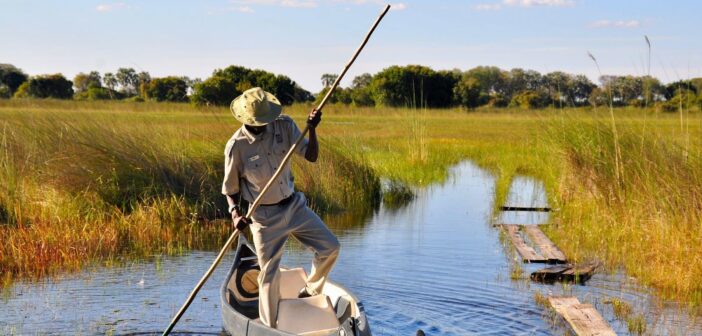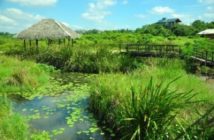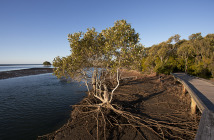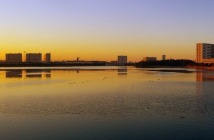The Okavango Delta is the world’s largest inland delta, which is located in Botswana, Southern Africa. The size of this prominent environment is approximately 16,000 sq. km in size. An inland delta is a landform which is created by deposition of sediment that is carried by a river as the flow leaves its mouth and enters slower-moving or stagnant water. These ecosystems often occur on former lake beds.
Okavango Delta belongs to both Moremi Wildlife Reserve and the Kalahari Desert. The Okavango Delta is created by the Okavango River (1600 km in length), which is the fourth longest river in Southern Africa and it drains onto surface of the Kalahari Desert. This world-famous delta has no connection to the sea. Even though, the salts reach the water body through the Okavango River, the Delta remains fresh. The land regenerates with different flood periods. The influx of around 2.5 trillion gallons of water, makes the Okavango Delta—a permanent swamp surrounded by one of the continent’s driest land extents.
Since the Cubango-Okavango River Basin covers 125,000 square miles in Angola, Namibia and Botswana and providing water for 1 million people, Local communities in the region are benefited from the delta as a major water source. Majority of people rely on livelihoods like agriculture, fishing, forestry and tourism that draw on the natural resources of the locality. This is also considered to be a famous tourist destination in this landscape. This ecosystem has a rich and unique biodiversity: around 500 bird species, 89 fish species, 128 mammal species, approximately 150 reptiles and amphibian species live in and around the Okavango Delta. Rare bird species such as Locust Finch (Ortygospiza locustella), Black-cheeeked Lovebird (Agapornis nigrigenis), White-backed Vulture (Gyps africanus) and Chestnut-banded Plover (Charadrius pallidus) live in the region. Moreover, rare and threatened mammals live in the delta, such as African Wild Dog (Lycaon pictus), Black Rhino (Diceros bicornis), African Elephant (Loxodonta africana), African Lion (Panthera leo) and Leopard (Panthera pardus). The Okavango Hinged Terrapin (Pelusios bechuanicus) is an endemic turtle who is observable in this exceptional environment.
The delta is divided into four areas, which are very different to each other concerning their ecology and flora. The so-called Panhandle, the underflow of the Okavango River, aquifers permanently, is covered with dense growth of papyrus species (Cyperus papyrus). The swamp areas at the end of the Panhandle, flooded permanently, are the second zone. This area creates a mosaic of open water surfaces and swimming islands. The areas at the periphery of the delta, which fall temporarily dry and considered to be seasonal swamps – are the third zone. The large islands (Chief Island, Chitabe Island) inside the delta and the tongues of sand, which reach the delta from the south, are the fourth zone. Approximately 1,300 different plants species are identified in the whole delta area.
The shore vegetation is also very different, there are mopane and baikea woodlands in the northern part of the delta. But also, areas of savannah, which are important for the African large mammals, semi-desert regions, grasslands and fields are visible in the surrounding of the delta.
The Okavango Delta is one of Botswana’s leading tourist areas due to its rich wildlife resources and the scenic beauty it inherits. The Okavango region has experienced vast development in parallel to the development of tourism industry. Tourism in the Okavango Delta also provides employment opportunities to local communities and it is a significant source of foreign exchange for Botswana. Despite its positive socio-economic impacts, the industry is beginning to have detrimental environmental impacts in the area such as the destruction of the area’s ecology through driving outside the prescribed trails, noise pollution and poor waste management. It is vital that the community and the responsible authorities be attentive to responsible tourism which gives the area a substantial value that prevents it being used for ranching to the impairment of wildlife and land.
Human settlements near this significant ecosystem have become a wide-reaching concern as the Okavango Delta is a Ramsar Site. Accelerated population growth and growing economic facilities near this area which is a tourist attraction is shown to be a major driving force behind human-settlement sprawl. As a result of increasing numbers of young educated people seeking urban employment, the urban sprawl can also be observed in this region. Furthermore, infrastructure development, associated with habitat fragmentation, is related economic expansion which are not always environmentally responsible. It is vital to take immediate and sustainable actions to address the primary causes for these threats which are, population growth, rural income opportunities, urban employment opportunities and environmentally inconsiderate infrastructure development. It is necessary to be attentive on these fast-moving changes in the surrounding environment and the social aspect of it.
Trans-boundary and upstream-downstream inequities are also affecting the management of the Okavango watershed. While Angola provides 95% of the delta’s water, it is Botswana that largely secures the majority of benefits of ecotourism centered on the region’s annual wildlife spectacle. In short, development decisions made upstream have a significant effect on the people and animals who live downstream. There are some important conservation initiative addressing these issues.
Since 2018, together with The Nature Conservancy (TNC), the government of Angola and the Permanent Okavango River Basin Water Commission (OKACOM) are in collaboration—as well as other organizations including the World Wildlife Fund, Peace Parks Foundation, Conservation International, Namibia Nature Foundation and National Geographic’s Okavango Wilderness Project—on a three-pronged approach that balances the needs of people and nature across the basin. The first goal is to plan smart development in the headwaters region of Angola. Community-based conservation is critical because people are dependent on natural resources. It is very important to let the local communities to take full ownership of these resources, manage them and also derive a livelihood.



